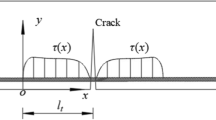Abstract
Experimental and numerical results are provided in this contribution to study the global and cracking behaviors of two reinforced concrete beams subjected to four point bending. Experimentally, the use of image correlation technique enables to obtain precise information concerning the cracking properties (spacing, cumulated, maximum and mean values of the opening). Numerically, two simulations are compared taking into account a bond model between steel and concrete or supposing a perfect relation between the two materials. In both cases, a good agreement is achieved between numerical and experimental results even if the introduction of the bond effects has a direct influence during the development of the cracks (better agreement during the “active” cracking phase).






























Similar content being viewed by others
References
Au FTK, Bai ZZ (2007) two-dimensional nonlinear finite element analysis of monotonically and nonreversed cyclically loaded RC beams. Eng Struct 29:2921–2934
Besnard G, Hild F, Roux S (2006) Finite element displacement field analysis from digital images: application to Portevin-Le Chatelier bands. Exp Mech 46:789–803
Casanova A, Jason L, Davenne L (2012) Bond slip model for the simulation of reinforced concrete structures. Eng Struct 39:66–78
Cast3m (2012) http://www-cast3m.cea.fr/
Castel A, François R (2011) Modeling of steel and concrete strains between primary cracks for the prediction of cover-controlled cracking in RC beams. Eng Struct 33:3668–3675
Clément JL (1987) Interface acier-béton et comportement des structures en béton armé- Caractérisation- Modélisation. PhD Thesis Université Paris 6
Costa C, Pegon P, Arêde A, Castro J (2004) Implementation of the damage model in tension and compression with plasticity in Cast3M. JRC Report
Daoud A (2003) Etudes expérimentales de la liaison entre l’acier et le béton autoplaçant - Contribution à la modélisation. PhD Thesis INSA Toulouse
Dominguez N, Ibrahimbegovic A (2012) A non-linear thermodynamical model for steel-concrete bonding. Comput Struct 106–107:29–45
Eligehausen R, Popov EP, Bertero VV (1983) Local bond stress - slip relationships of deformed bars under generalized excitations. Report \(\text{ n}^{\circ }\) UCB/EERC-83/23 University of California
Eurocode 2 (2007) Calcul des structures en béton. NF-EN-1992
Ferreira MDC, Venturini WS, Hild F (2011) On the analysis of notched concrete beams : from measurement with digital image correlation to identification with boundary element method of a cohesive model. Eng Fract Mech 78:71–84
Harajli MH (1994) Development/splice strength of reinforcing bars embedded in plain and fiber reinforced concrete. ACI Struct J 9:511–520
Hillerborg A, Modeer M, Peterson PE (1976) Analysis of crack formation and crack growth in concrete by means of fracture mechanic and finite elements. Cem Concr Res 6:773–782
Ibrahimbegovic A, Boulkertous A, Davenne L, Brancherie D (2010) Modeling of reinforced-concrete structures providing crack spacing based on XFEM, ED-FEM and novel operator split solution procedure. Int J Numer Methods Eng 83:452–481
Khalfallah S, Ouchenane M (2007) Numerical solution of bond for pull-out test: the direct problem. Asian J Civ Eng 8:491–505
Kwak HG, Kim SP (2001) Bond slip behavior under monotonic uniaxial loads. Eng Struct 23:238–309
Lowes LN, Moehle JP, Govindjee S (2004) Concrete-steel bond model for use in finite element modeling of reinforced concrete structures. ACI Struct J 101:501–511
Matallah M, La Borderie C, Maurel O (2010) A practical method to estimate crack opening in concrete structures. Int J Numer Anal Methods Geomech 34:1615–1633
Mivelaz P (1996) Etanchéité des structures en béton armé- Fuites au travers d’un élément fissuré. PhD thesis Ecole Polytechnique Fédérale de Lausanne
Ngo D, Scordelis AC (1967) Finite element analysis of reinforced concrete beams. ACI J 64:152–163
Nilson AH (1968) Nonlinear analysis of reinforced concrete by the finite element method. ACI J 65:757–766
Oliveira RS, Ramalho MA, Corrêa MRS (2008) A layered finite elements for reinforced concrete beams with bond-slip effects. Cem Concr Compos 30:245–252
Picandet V, Khelidj A, Bastian G (2001) Effect of axial compressive damage on gas permeability of ordinary and high performance concrete. Cem Concr Res 31:1525–1532
Ragueneau F, Dominguez N, Ibrahimbegovic A (2006) Thermodynamic-based interface model for cohessive brittle materials: application to bond slip in RC structures. Comput Methods Appl Mech Eng 195:7249–7263
Torre-Casanova A (2012) Prise en compte de la liaison acier-béton pour le calcul de structures industrielles. Phd Thesis Ecole Normale Supérieure de Cachan
Torre-Casanova A, Jason L, Davenne L, Pinelli X (2013) Confinement effects on the steel-concrete bond strength and pull-out failure. Eng Fract Mech 97:92–104
Acknowledgments
The authors would like to thank Prof. F. Hild for his helpful discussions concerning the image correlation technique.
Author information
Authors and Affiliations
Corresponding author
Rights and permissions
About this article
Cite this article
Jason, L., Torre-Casanova, A., Davenne, L. et al. Cracking behavior of reinforced concrete beams: experiment and simulations on the numerical influence of the steel-concrete bond. Int J Fract 180, 243–260 (2013). https://doi.org/10.1007/s10704-013-9815-6
Received:
Accepted:
Published:
Issue Date:
DOI: https://doi.org/10.1007/s10704-013-9815-6



